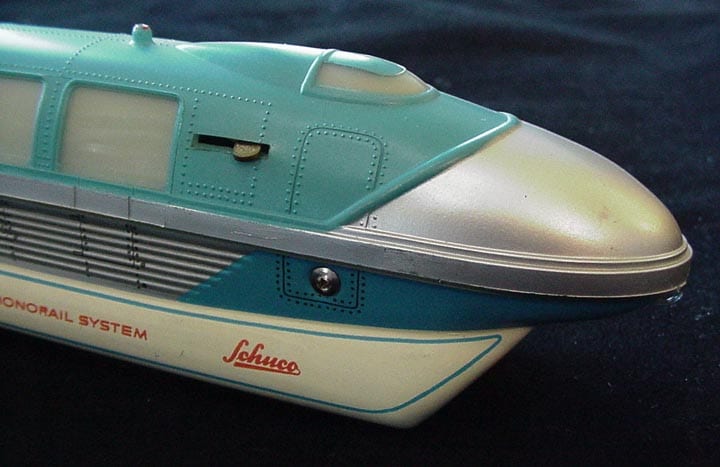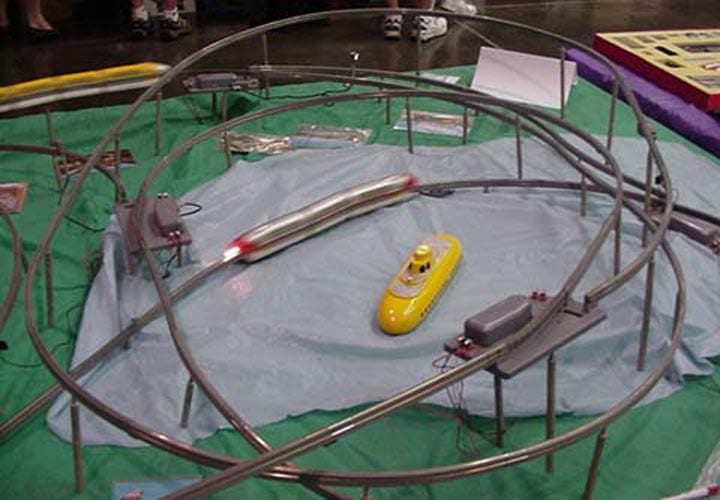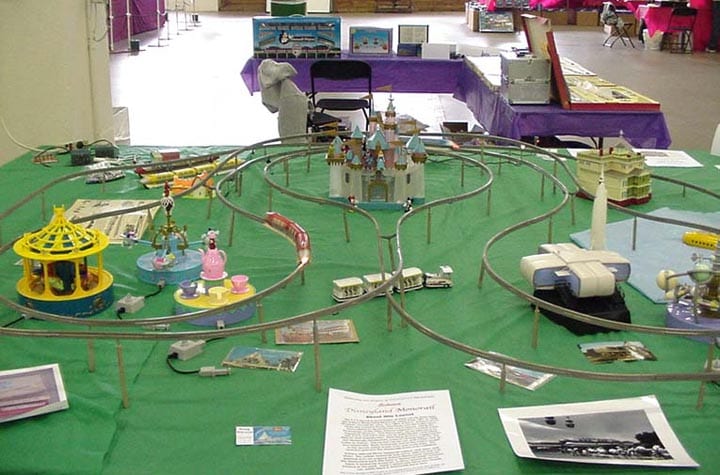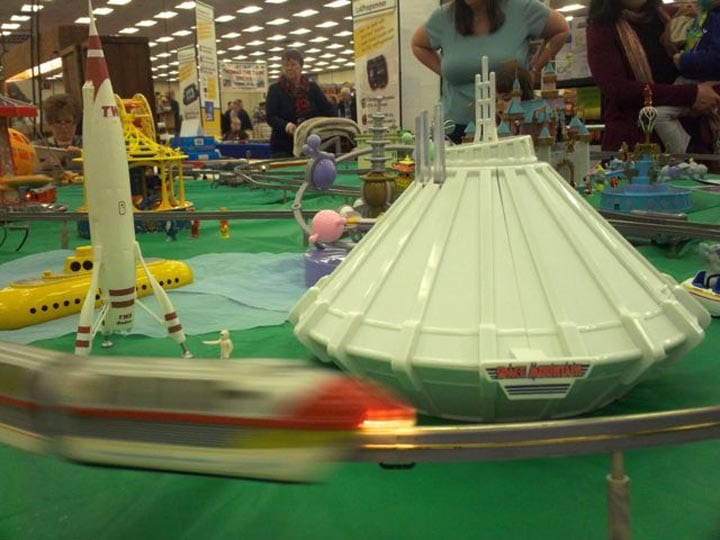Schuco and Their Classic Toy Train: Running the Disneyland Monorails
By Doug Burwell TCA #81-16885
A great experience for me at a train show is watching someone recognize the Schuco Disneyland monorails and exclaim that they have a set at home, but it is missing parts. At two day events, I tell them to come back the next day with their set, and I will attempt to make it complete. It is extremely rewarding to return a 50 year old set back to its original status.
But even more exciting is checking to see if their collectible monorail, which has probably been setting idle for several decades, will run. After installing new wheels and adding a couple of drops of oil, I have never failed to get one running under these circumstances. The joy on the owner’s face as he watches his monorail come to life on my layout makes my travels all worthwhile.
The majority of the Schuco monorail tracks contain brass rails. Brass does not rust, but it does tarnish over 50 years of time. Tracks need to be cleaned so that all the brass is shiny. This takes some time, but once done, using the “warm up” program mentioned below will keep them clean.
A few steps need to be taken to get a Schuco Disneyland monorail to run. Some of the basics of all model railroading apply: tracks must be clean and the electrical pickups on the power unit must be clean. With Schuco monorails, there are two more factors to consider: install new wheels and have a DC output transformer that delivers 20 or more volts.
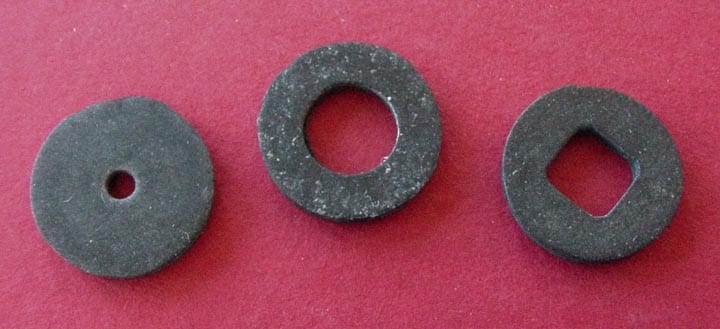
All the monorails have four rubber wheels on them. After 40 or 50 years, the rubber dries out. On top of that, I believe that the rubber originally used by Schuco in the 60’s was probably hard to begin with. Today, there are reproduction wheels available. These German made reproduction wheels consist of a softer rubber and really grip the track. I automatically replace the original Schuco wheels, even if the monorail appears to be in Like New or better condition. This is the first step in successfully running the monorails.
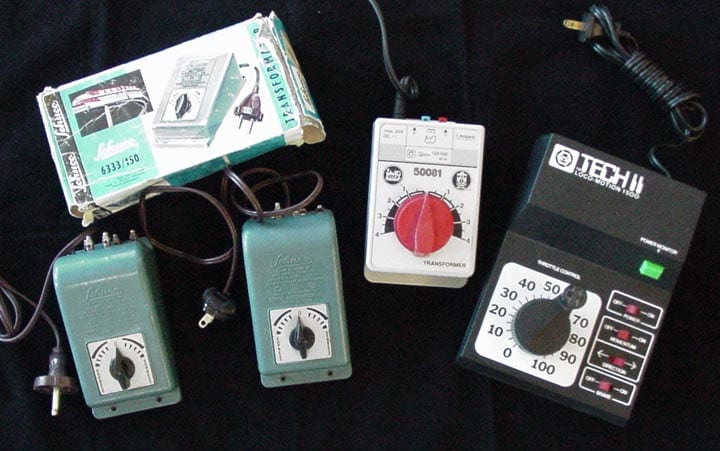
The next mistake a lot of new Schuco Disneyland monorail operators make is using a typical HO train transformer. They have read in the Schuco manual that the monorails require a 17 volt, DC output transformer. This is where the confusion begins. Schuco actually should have said that an operator needs a transformer that can put out 17 volts under a .5 amp load. There is a big difference. The 6333/150 Schuco transformer at full throttle actually puts out 30 volts at no load.
Put two trains on the track (about a .5 amp load) with the transformer dial at maximum and the voltmeter will show 17 volts. Most train transformers for the U.S.A. market state their output at no load. My experience is that an operator of the monorails will need a minimum of 20 volts at no load, but more voltage is better. I like using the original 6333/150 Schuco transformer, but many operators swear by the more modern LGB 50081 which has a super clean 24 volt, DC output and uses modern technology.
Once new wheels have been installed and the correct transformer chosen, when I first run the monorails I like to do what I call a “warm up” program. I put just the engine unit on the track, turn the transformer to maximum, and let the monorail buzz around the track. A recommended option is to add a drop of electrical conductive fluid like Rail Zip to the monorail’s pickup points while doing this.
This “warm up” self-cleans the tracks and gets those 50 year old parts going. There are no worries about running the monorail at full speed because it cannot derail, another bonus point for operating Schuco Disneyland monorails and allowing kids to run them! After a few laps around the layout, I add the rest of the cars to the monorail and select a lower voltage. A note here is that the Schuco monorails were made to run fast. The actual monorail at Disneyland runs at its fastest point around 30mph. The slowest scale speed you can run a Schuco Disneyland monorail is probably around 60mph, but it runs smoother around 120mph to 180mph.
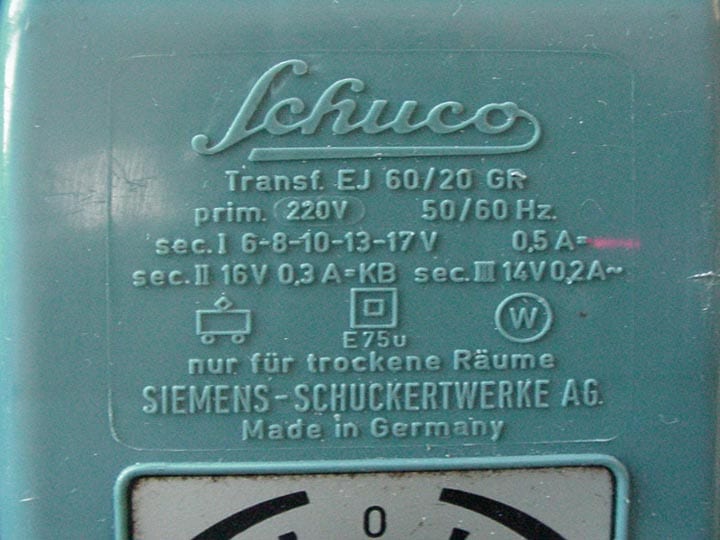
The German engineers at Schuco designed a well- built model train. The fact that they still operate and are very reliable 50 years later is a great testimonial. But the engineers did not stop at just making a well-built monorail. They added several operational features to the entire system.
First, the tracks consist of three rails. This allows the operator to have complete control of two monorails occupying one track. To do this, two transformers are needed. Both transformers share the common top rail, but only one side rail is assigned to each transformer. The switch on the side of the monorail determines if that unit picks up power from the right or left rail.
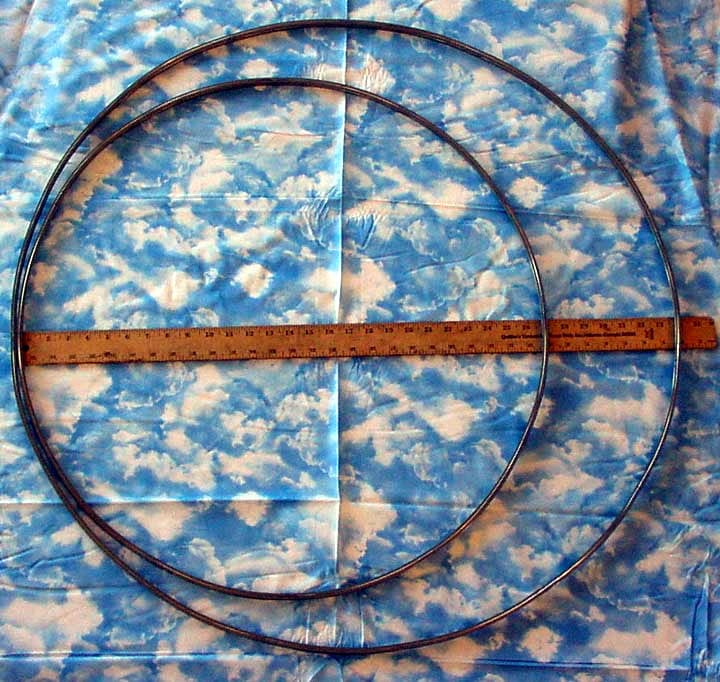
Another feature of the track is that they are flexible! The tightest 90 degree turn takes three curved tracks, but one could use 4 or more tracks to make a wider 90 degree turn. The tightest circle of track for the monorails measures around 27” in diameter (there must have been a Lionel 027 fan amongst the German engineers at Schuco), but since the tracks are flexible, there is an infinite combination of curves to make a wider circle.

extended weight plate, and 6333/20 switches.
The next imaginative function was the creation of the 6333/26 automatic controller. This device is activated by a monorail passing over it, and it in turn controls the 6333/20 switches. Thus, the monorails control their own paths in a layout. The 6333/26 is activated by an extended weight plate (6333/26/1) in the monorail. This plate can be placed on the right or left side of the monorail. Depending where an operator puts the extended weight plate, one monorail may trigger the automatic controller while another has no effect. A layout can have a series of automatic controllers which can create a variety of destinations for the monorails. The electric switches are wired so that an open switch will kill the power to the track, thus they can be used to create blocking systems in a layout. A monorail approaching an open switch will stop. When the switch is closed, the monorail will continue its journey.
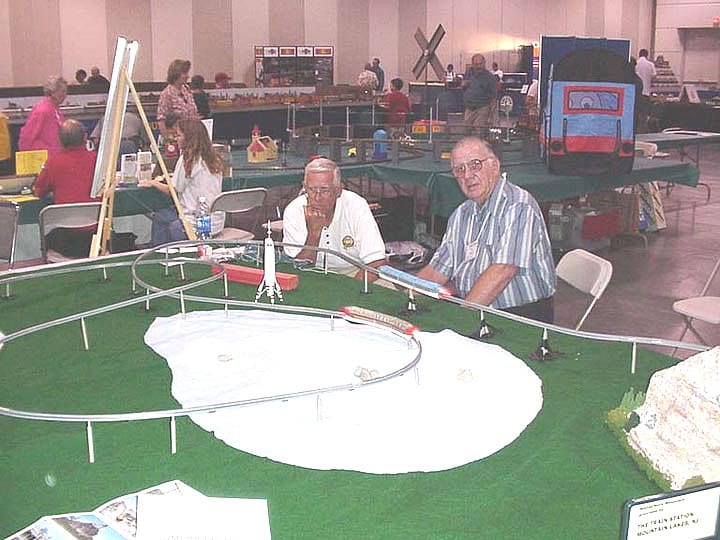

I try to design a new and unique layout for every train show I do. I like having two or more monorails running at one time and switching each other to various destinations. At just about every show someone will ask me if the layout is controlled by a computer. Of course, no one had a home computer during the 1960’s. The Schuco engineers used the technology they had at the time, and did an incredible job.
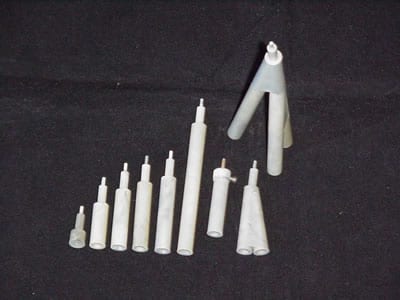
Schuco made six different heights of stackable pylons to raise the tracks: 7mm (6333/26/2), 25mm (6333/62), 35mm (6333/63), 40mm (6333/64), 45mm (6333/65), and 80mm (6333/66). An operator can stack a combination of these to create different heights. A pylon should be placed at least every other track. Though Schuco displayed several layouts in their manual showing very steep grades, I recommend no more than 25mm difference between two tracks. This is about a 7% grade.
Yes, the monorails will climb a steeper grade, especially with the new reproduction wheels, but I find sticking with the 25mm rule keeps the monorails running smoothly as they ascend and descend. When crossing over another track, I recommend at least 50mm of clearance. If for some reason an operator could not get the exact pylon height he or she needed, Schuco did make the 6333/68 adjustable pylon which could be stacked on top of another pylon and then adjusted to add 40 to 60 more millimeters of height.
Overall, Schuco offered more than 40 layout accessories. One of my favorites is the 6333/71 dual rail supports. Using this creates parallel tracks in which two monorails can race side by side, or pass in opposite directions. The dual rail supports can also be used to straddle an existing HO train track below the monorail, or create another monorail track above.
Maintenance of the monorails is about the same as most model trains. Oil the motor axles every 20 to 30 hours of operation and the reproduction wheels should last around 300 hours. Switches, which have the same motor as the monorails, should be oiled every year or two.
Watching the Schuco Disneyland monorails buzzing around a layout is very enjoyable. Some say they are hypnotizing. It is also fun to observe people watching the monorails. My experience is that women tend to relate more to the monorails than to your standard model trains. Young children associate the monorails with a fun family trip they experienced at one of the Disney parks. As for us train guys? Well, the monorails are another one of those magical links to model trains and a connection for many of us to the past, and hopefully to the future!
Author’s note: If you would like to see all of the Schuco Disneyland monorail accessories offered, please visit my website: SchucoDisneylandMonorail.com.
Visit the “Facts” pages for pictures of all the accessories and the boxes they came in.


